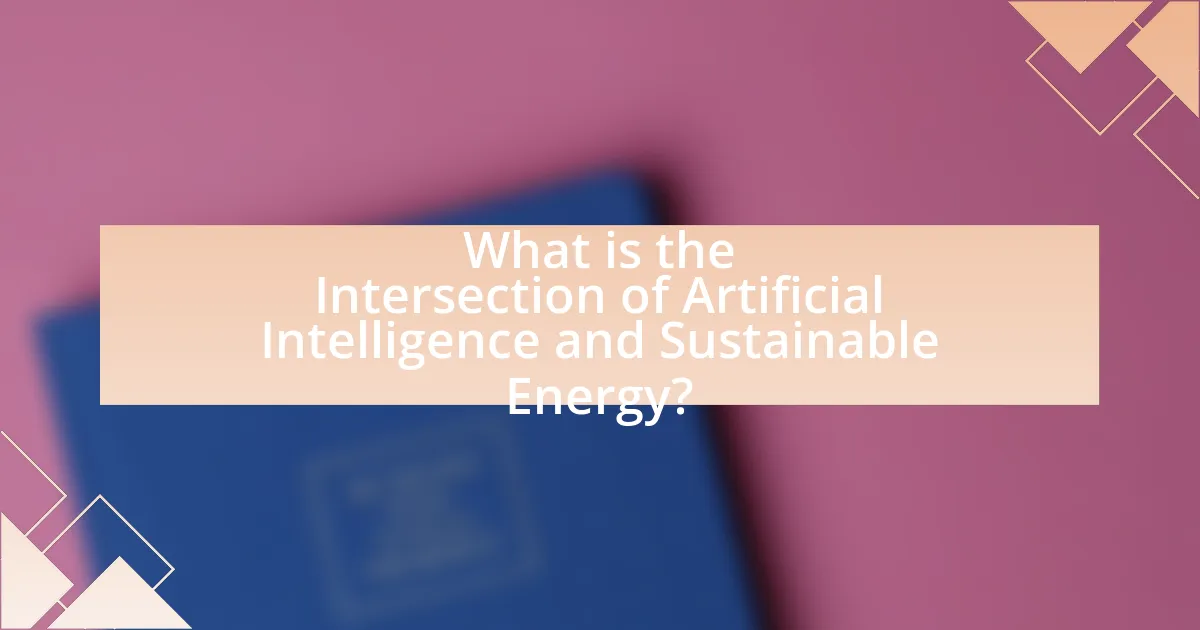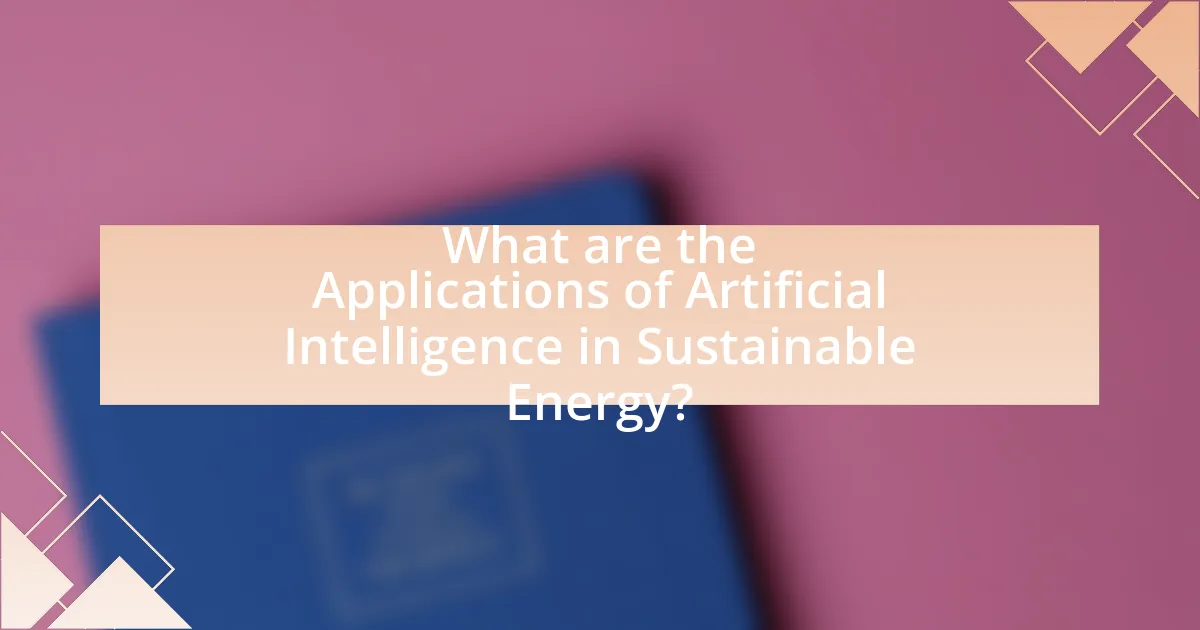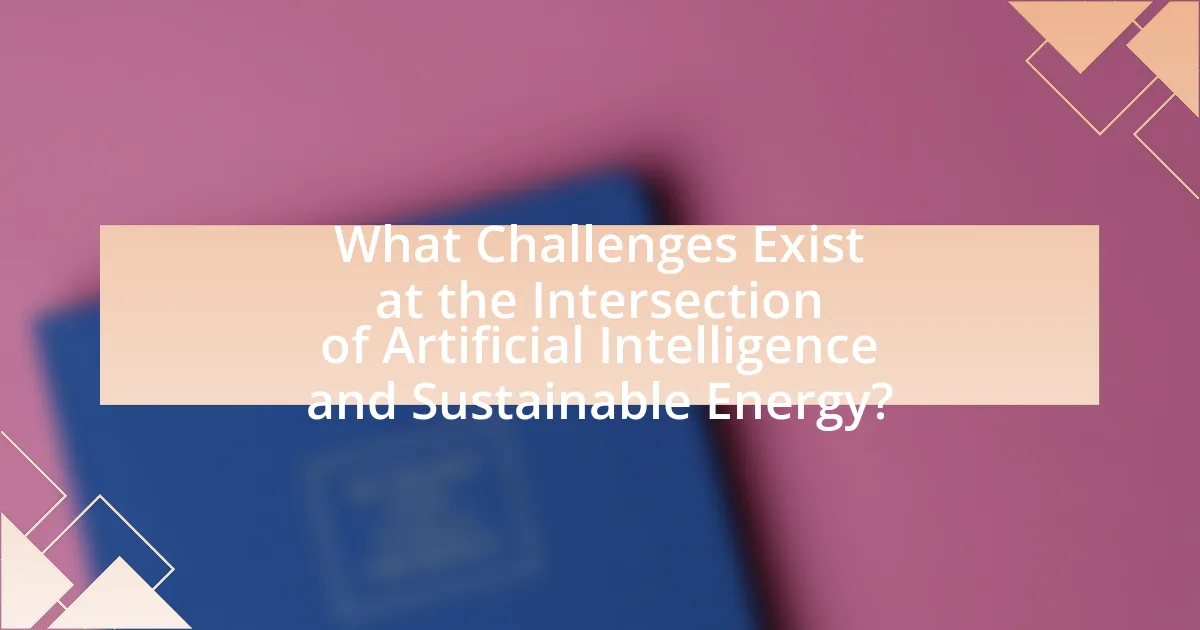The article explores the intersection of artificial intelligence (AI) and sustainable energy, highlighting how AI technologies optimize energy production, consumption, and management to enhance sustainability. It discusses the role of AI in improving the efficiency of renewable energy systems, such as solar and wind, through predictive maintenance and demand forecasting, potentially reducing carbon emissions and operational costs. Key technologies, including machine learning and predictive analytics, are examined for their contributions to energy efficiency and grid management. The article also addresses challenges such as data quality, integration complexity, and ethical considerations, emphasizing the importance of AI in addressing global energy challenges and promoting the adoption of renewable energy sources.

What is the Intersection of Artificial Intelligence and Sustainable Energy?
The intersection of artificial intelligence and sustainable energy involves the application of AI technologies to optimize energy production, consumption, and management, thereby enhancing sustainability. AI algorithms analyze vast datasets from renewable energy sources, such as solar and wind, to predict energy output and improve grid management. For instance, a study by the International Renewable Energy Agency (IRENA) highlights that AI can increase the efficiency of renewable energy systems by up to 30% through predictive maintenance and demand forecasting. This integration not only reduces carbon emissions but also promotes the transition to a more resilient and efficient energy system.
How do Artificial Intelligence and Sustainable Energy interact?
Artificial Intelligence (AI) enhances the efficiency and effectiveness of sustainable energy systems. AI algorithms optimize energy consumption, predict energy demand, and improve the integration of renewable energy sources like solar and wind. For instance, AI can analyze vast datasets from smart grids to forecast energy usage patterns, enabling better load management and reducing waste. According to a report by the International Energy Agency, AI applications in energy could reduce global greenhouse gas emissions by up to 4% by 2030, demonstrating the significant impact of AI on promoting sustainable energy solutions.
What are the key technologies in Artificial Intelligence that support Sustainable Energy?
Key technologies in Artificial Intelligence that support Sustainable Energy include machine learning, predictive analytics, and optimization algorithms. Machine learning enables the analysis of vast datasets to improve energy efficiency and predict energy demand patterns. Predictive analytics helps in forecasting renewable energy generation, such as solar and wind, allowing for better integration into the energy grid. Optimization algorithms enhance the management of energy resources, ensuring that supply meets demand efficiently. These technologies collectively contribute to reducing carbon emissions and promoting the use of renewable energy sources, as evidenced by studies showing that AI can increase energy efficiency by up to 20% in various sectors.
How does data analysis in AI contribute to energy efficiency?
Data analysis in AI significantly enhances energy efficiency by optimizing resource allocation and consumption patterns. Through advanced algorithms, AI analyzes vast datasets from energy usage, weather patterns, and operational metrics to identify inefficiencies and predict demand. For instance, a study by the International Energy Agency found that AI applications in energy management can reduce energy consumption by up to 10-20% in industrial settings. This optimization leads to lower operational costs and reduced carbon emissions, demonstrating the tangible benefits of integrating AI-driven data analysis in energy systems.
Why is the intersection of these fields important for the future?
The intersection of artificial intelligence and sustainable energy is crucial for the future because it enables the optimization of energy systems, leading to increased efficiency and reduced carbon emissions. AI technologies can analyze vast amounts of data to improve energy management, predict energy demand, and enhance the integration of renewable energy sources. For instance, a study by the International Renewable Energy Agency (IRENA) highlights that AI can reduce energy consumption in buildings by up to 30% through smart management systems. This synergy not only supports the transition to a low-carbon economy but also fosters innovation in energy solutions, making it essential for addressing climate change and ensuring energy security.
What global challenges can be addressed through this intersection?
The intersection of artificial intelligence and sustainable energy can address global challenges such as climate change, energy efficiency, and resource management. Climate change can be mitigated through AI-driven models that optimize renewable energy sources, reducing greenhouse gas emissions. For instance, AI algorithms can predict energy demand and supply fluctuations, enabling better integration of solar and wind energy into the grid, which is crucial as renewable energy sources accounted for 29% of global electricity generation in 2020. Additionally, AI can enhance energy efficiency in buildings and industrial processes, potentially reducing energy consumption by up to 20% according to the International Energy Agency. Furthermore, AI can improve resource management by optimizing the use of materials and minimizing waste, addressing the challenge of resource depletion.
How can AI-driven solutions enhance renewable energy adoption?
AI-driven solutions can enhance renewable energy adoption by optimizing energy management and improving predictive analytics. These technologies enable more efficient integration of renewable sources like solar and wind into existing energy grids, thereby increasing their reliability and reducing costs. For instance, AI algorithms can analyze vast amounts of data to forecast energy production and consumption patterns, allowing for better grid management and reduced reliance on fossil fuels. According to a report by the International Renewable Energy Agency, AI can potentially reduce operational costs in renewable energy systems by up to 20%, making them more competitive with traditional energy sources.

What are the Applications of Artificial Intelligence in Sustainable Energy?
Artificial Intelligence (AI) is applied in sustainable energy through optimization of energy consumption, predictive maintenance, and integration of renewable energy sources. AI algorithms analyze data from smart grids to enhance energy efficiency, reducing waste and costs. For instance, AI can predict energy demand patterns, allowing for better load management and resource allocation. Additionally, AI-driven predictive maintenance helps in identifying potential failures in renewable energy systems, such as wind turbines and solar panels, thereby minimizing downtime and maintenance costs. According to a report by the International Renewable Energy Agency, AI technologies can improve the efficiency of renewable energy systems by up to 30%, demonstrating their significant impact on sustainable energy initiatives.
How is AI used in energy management systems?
AI is used in energy management systems to optimize energy consumption and enhance efficiency. By analyzing vast amounts of data from various sources, AI algorithms can predict energy demand, identify patterns, and recommend adjustments to reduce waste. For instance, AI can facilitate real-time monitoring and control of energy usage in buildings, leading to energy savings of up to 30% as reported by the U.S. Department of Energy. Additionally, AI-driven predictive maintenance can minimize downtime and operational costs by forecasting equipment failures before they occur.
What role does predictive analytics play in energy consumption?
Predictive analytics plays a crucial role in energy consumption by enabling more efficient energy management and forecasting demand. By analyzing historical data and identifying patterns, predictive analytics helps utilities and consumers anticipate energy needs, optimize resource allocation, and reduce waste. For instance, a study by the U.S. Department of Energy found that predictive analytics can improve load forecasting accuracy by up to 20%, leading to significant cost savings and enhanced grid reliability. This data-driven approach supports the transition to sustainable energy by facilitating better integration of renewable sources and promoting energy conservation strategies.
How can AI optimize grid management and reliability?
AI can optimize grid management and reliability by utilizing predictive analytics and real-time data processing to enhance decision-making. By analyzing historical consumption patterns and forecasting demand, AI algorithms can predict peak usage times, allowing grid operators to allocate resources more efficiently. For instance, a study by the National Renewable Energy Laboratory found that AI-driven demand response systems can reduce peak load by up to 20%, significantly improving grid stability. Additionally, AI can identify potential faults in the grid infrastructure through anomaly detection, enabling proactive maintenance and reducing downtime. This capability not only enhances reliability but also minimizes operational costs, as evidenced by a report from McKinsey, which states that AI applications in energy management can lead to cost savings of 10-20%.
What are the implications of AI in renewable energy sources?
AI significantly enhances the efficiency and effectiveness of renewable energy sources. By optimizing energy production and consumption, AI algorithms can predict energy demand, manage grid operations, and improve the integration of renewable sources like solar and wind into existing energy systems. For instance, a study by the International Renewable Energy Agency (IRENA) found that AI can increase the efficiency of solar panels by up to 20% through predictive maintenance and performance monitoring. Additionally, AI-driven analytics can facilitate better energy storage solutions, ensuring that renewable energy is available even when production is low. These advancements not only reduce operational costs but also contribute to a more sustainable energy future by maximizing the use of clean energy resources.
How does AI improve solar energy forecasting?
AI improves solar energy forecasting by utilizing advanced algorithms and machine learning techniques to analyze vast amounts of data, including weather patterns, historical solar generation, and geographical information. These algorithms can identify complex patterns and correlations that traditional forecasting methods may overlook, leading to more accurate predictions of solar energy output. For instance, a study published in the journal “Renewable Energy” demonstrated that AI-based models could enhance forecasting accuracy by up to 30% compared to conventional methods, significantly optimizing energy management and grid stability.
What advancements has AI brought to wind energy efficiency?
AI has significantly enhanced wind energy efficiency through predictive maintenance, optimized turbine performance, and improved energy forecasting. Predictive maintenance utilizes machine learning algorithms to analyze data from turbine sensors, allowing for timely repairs and reducing downtime, which can lead to efficiency improvements of up to 10%. Additionally, AI algorithms optimize turbine operations by adjusting blade angles and speeds in real-time based on wind conditions, resulting in increased energy capture. Furthermore, AI-driven energy forecasting models improve grid integration by accurately predicting wind energy output, which enhances the reliability of renewable energy sources. These advancements collectively contribute to a more efficient and sustainable wind energy sector.

What Challenges Exist at the Intersection of Artificial Intelligence and Sustainable Energy?
The challenges at the intersection of artificial intelligence and sustainable energy include data quality, integration complexity, and ethical considerations. Data quality issues arise because AI systems require large amounts of accurate and relevant data to function effectively; however, inconsistent or incomplete data can lead to unreliable outcomes. Integration complexity is a challenge as AI technologies must be seamlessly integrated into existing energy systems, which often involves overcoming technical barriers and ensuring compatibility with various energy sources and infrastructures. Ethical considerations also pose challenges, particularly regarding the transparency of AI decision-making processes and the potential for bias in energy distribution and access. These challenges highlight the need for robust frameworks and standards to guide the responsible deployment of AI in sustainable energy initiatives.
What are the ethical considerations of using AI in energy systems?
The ethical considerations of using AI in energy systems include issues of fairness, transparency, accountability, and privacy. Fairness is crucial as AI algorithms must ensure equitable access to energy resources and avoid bias in energy distribution, which can disproportionately affect marginalized communities. Transparency is essential for understanding how AI systems make decisions, particularly in optimizing energy consumption and generation, as stakeholders need to trust these systems. Accountability involves establishing who is responsible for the outcomes of AI-driven decisions, especially in cases of system failures or unintended consequences. Privacy concerns arise from the data collection required for AI systems, necessitating robust data protection measures to safeguard personal information. These considerations are supported by research indicating that ethical frameworks in AI can enhance public trust and promote sustainable energy practices.
How can bias in AI algorithms affect energy distribution?
Bias in AI algorithms can lead to unequal energy distribution by favoring certain demographics or regions over others. For instance, if an AI system is trained on historical data that reflects existing inequalities, it may prioritize energy resources for affluent areas while neglecting underserved communities. A study by the National Renewable Energy Laboratory found that biased algorithms could exacerbate disparities in energy access, resulting in lower energy efficiency and higher costs for marginalized populations. This highlights the critical need for equitable data representation in AI training to ensure fair energy distribution.
What measures can be taken to ensure transparency in AI applications?
To ensure transparency in AI applications, organizations can implement clear documentation practices, establish explainable AI models, and engage in regular audits. Clear documentation provides stakeholders with insights into the data sources, algorithms, and decision-making processes used in AI systems. Explainable AI models, which are designed to make the reasoning behind AI decisions understandable, enhance user trust and accountability. Regular audits, conducted by independent third parties, can verify compliance with ethical standards and regulatory requirements, ensuring that AI systems operate transparently and responsibly. These measures collectively foster an environment of trust and accountability in AI applications.
What technical challenges must be overcome for successful integration?
Successful integration of artificial intelligence and sustainable energy requires overcoming several technical challenges, including data interoperability, algorithmic efficiency, and system scalability. Data interoperability is crucial as diverse energy systems generate data in various formats, necessitating standardized protocols for seamless communication. Algorithmic efficiency is essential to ensure that AI models can process large datasets in real-time, which is vital for optimizing energy consumption and generation. System scalability must be addressed to accommodate the growing complexity and size of energy networks, ensuring that AI solutions can adapt to increasing demands without compromising performance. These challenges are supported by industry reports indicating that effective data management and advanced algorithms are pivotal for enhancing energy system resilience and efficiency.
How do data privacy concerns impact AI in energy sectors?
Data privacy concerns significantly impact AI in energy sectors by limiting data sharing and collaboration necessary for effective AI model training and deployment. Energy companies often handle sensitive consumer data, and stringent regulations like GDPR enforce strict compliance, which can hinder the availability of data for AI applications. For instance, a study by the International Energy Agency highlights that data-driven AI solutions can enhance energy efficiency, but privacy regulations may restrict access to valuable datasets, ultimately slowing innovation and implementation of AI technologies in the sector.
What infrastructure improvements are necessary for AI deployment?
Infrastructure improvements necessary for AI deployment include enhanced computational power, robust data storage solutions, and improved network connectivity. Enhanced computational power is critical as AI algorithms require significant processing capabilities, often necessitating advanced hardware like GPUs or TPUs. Robust data storage solutions are essential to handle the vast amounts of data generated and required for training AI models, with cloud storage options providing scalability and accessibility. Improved network connectivity, particularly through high-speed internet and low-latency connections, is vital for real-time data processing and seamless integration of AI systems across various platforms. These improvements are supported by industry trends indicating that organizations investing in these areas experience better AI performance and efficiency.
What are best practices for implementing AI in Sustainable Energy?
Best practices for implementing AI in sustainable energy include integrating predictive analytics for energy consumption forecasting, optimizing grid management through real-time data analysis, and enhancing renewable energy resource management. Predictive analytics can improve energy efficiency by analyzing historical consumption patterns, which helps in demand response strategies. Real-time data analysis allows for better grid stability and reliability, as AI can identify and mitigate potential outages or inefficiencies. Furthermore, AI can optimize the integration of renewable resources, such as solar and wind, by predicting their availability and adjusting energy distribution accordingly. These practices are supported by studies showing that AI can reduce operational costs by up to 20% in energy management systems, thereby validating their effectiveness in promoting sustainability.